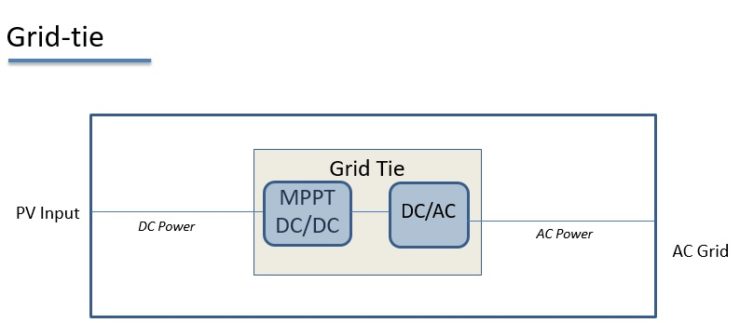Grid-tie inverter
A grid-tie solar inverter (also known as an on-grid solar inverter) has several functions that ultimately allow electricity produced by a solar array to be injected into the grid. This injected energy can either be self-consumed (consumed by the loads, appliances on the production site) or exported into the public electricity distribution network (to be sold to an electricity supplier for example). The main functions of the grid-tie solar inverter are:
-
- Convert the DC energy generated by the solar installation into an AC energy compatible with the local network (230VAC / 50Hz in Europe). Indeed, the current generated by the solar installation cannot be used directly since it is a Direct Current, which varies according to different factors such as solar irradiance, temperature, etc. … The grid-tie inverter will therefore convert this direct current into Alternating Current with a voltage and frequency identical to those present int the outlets, allowing consumption or export of solar production.
Below the internal diagram of a grid-tie inverter

- The grid-tie inverter will synchronize its output signal with that of the grid to be able to inject the solar energy to grid.
- Each grid-tie inverter has (or should have) an integrated anti-islanding protection. In fact, it is necessary for the grid-tie inverter to stop injecting energy into the grid and physically disconnect itself from the network when it fails (in case of the grid failure or voltage and / or frequency which go outside a certain range). There is a European standard called “DIN V VDE 0126-1-1” which defines the rules for decoupling, and there are many other similar norms applicable in various geographical areas. The grid-tie inverter therefore incorporates a relay which will open to decouple the inverter from the grid if necessary.
This last function of the grid-tie inverter is responsible for its main drawback. The grid-tie inverter will not be able to supply electricity during grid outages (no backup functionality). The owners of these inverters will therefore continue to endure power outages, despite having solar power plants capable of production of electricity.
Solar grid-tie inverters have another major drawback when used for solar installations dedicated to self-consumption in the residential sector. The power of the inverter should generally not exceed 1kW or 1.5kW because otherwise, the amount of excess energy production, which generates little or no gain at all, will be significant. To understand this phenomenon, refer to the graph below which superimposes a profile of residential electricity consumption and a profile of solar production.

We can therefore conclude that grid-tie inverters are well suited for installations with powers below 1000Wp, in areas that are never subjected to power cuts.
For higher power installations in the residential sector, there is another type of inverter, called a hybrid inverter, which gives the possibility of adding batteries to the installation in order to store the excess production for the evening or night.
The hybrid inverters manufactured by IMEON ENERGY have a design architecture which is similar to a grid-tie inverter and therefore have the DIN V VDE 0126-1-1 standard. However, IMEON hybrid inverters are also able to supply the electricity to the appliances via the dedicated “AC Back-up” connector during the power outages, while respecting the standard.
Here is the DIN V VDE 0126-1-1 certificate for an IMEON inverter
Here are the different data provided by the manufacturers of grid-tie inverters in their technical sheets:
- Nominal output power: this value describing how much power your inverter can output continuously, given in watts (W) or in kilowatts (kW).
- Output voltage: communicated in V (volts) or Vac (volts alternating current). It is necessary to make sure that the selected inverter can synchronise with local grid in your geographic area.
- Max efficiency: this is the maximum conversion efficiency between the output of the solar panels and the output of the inverter. The closer the efficiency of the inverter is to 100%, the less losses there are.
- Maximum DC voltage: communicated in V (volts) or Vdc (volts direct current), this is the voltage output of the solar array which should not be exceeded. The voltage will be determined by the number and type, brand of solar panels. When sizing the installation, one must take into account the specifications of the solar panels (don’t forget the temperature coefficients) to define number of panels which can be coupled with the inverter.
- Maximum DC current: communicated in amperes (A), this is the current produces by the solar array, measured on the solar panel input of the inverter.
- MPPT voltage range: communicated in V (volts) or Vdc (volts direct current), this is the solar array’s voltage range within which the inverter is able to generate electricity. When sizing the installation, one must ensure that the panels will be able to supply a voltage within this range during operation.
- Start-up voltage: communicated in V (volts) or Vdc (volts direct current), this is the voltage from which the inverter is able to generate electricity. When sizing your installation, you must ensure that the panels will be able to output the voltage higher than this value.
- Certifications: as the inverter is connected to the public electricity distribution network, it is mandatory that it complies with the standards in force in your geographical area.
- Type of inverter: the inverter can be with transformer or without transformer (TL for transformless). Inverters without transformers generally have higher conversion yields than inverters with transformers. Make sure that the panels you have chosen are compatible with the inverter.
Below is a table showing the advantages of the grid-Tie inverter.
| Grid-Tied | |
| Self-Consumption | + |
| Electrification of isolated sites | – |
| Back-Up | – |
| Yield | +++ |
| Battery Management | – |
| Ease of Installation | +++ |
| Cost Savings | + |
| Price | +++ |
